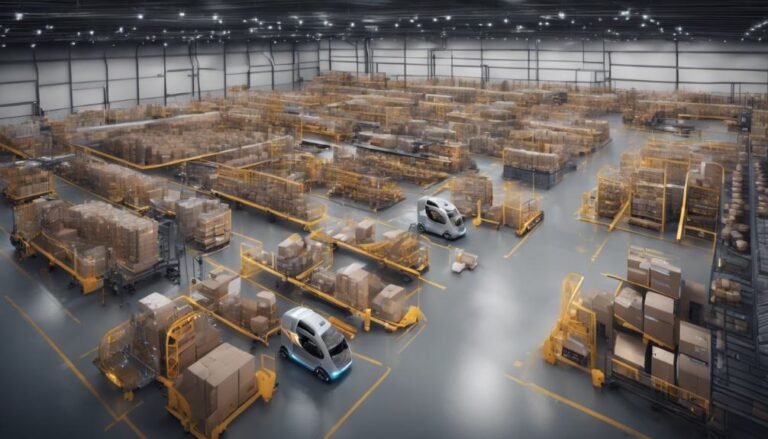AI for Risk Management
In the intricate web of risk management, AI acts as a vigilant sentinel, tirelessly scanning for hidden dangers and potential disruptions. Harnessing the power of artificial intelligence, organizations can navigate treacherous waters with a newfound clarity and precision. But how exactly does AI achieve this remarkable feat, and what are the implications for the future of risk management? Let's unravel the mysteries together and explore the transformative impact of AI in mitigating risks and securing a resilient future.
Key Takeaways
- AI automates data analysis and prediction processes in risk management.
- Machine learning algorithms identify patterns and anomalies in vast datasets.
- Predict future trends by analyzing historical data using AI-powered tools.
- Enhance decision-making with AI for proactive risk identification and mitigation.
- Utilize predictive risk modeling to prioritize mitigation efforts effectively.
The Role of AI in Risk Management
AI plays a pivotal role in enhancing risk management practices by automating data analysis and prediction processes. In the domain of risk assessment, machine learning algorithms are particularly effective at identifying patterns and anomalies within vast datasets, enabling organizations to make more informed decisions regarding potential risks.
Machine learning models can analyze historical data to predict future trends, helping businesses anticipate and mitigate potential risks before they escalate.
By leveraging machine learning for risk assessment, organizations can streamline the identification of potential threats and vulnerabilities, allowing for more proactive risk management strategies. These algorithms can continuously learn and adapt based on new data inputs, improving the accuracy and efficiency of risk assessment processes over time.
Additionally, machine learning can aid in the prioritization of risks based on their potential impact and likelihood of occurrence, enabling organizations to allocate resources effectively to address the most critical issues first.
AI-Powered Risk Analysis Tools
In the context of modern risk management practices, the utilization of AI-powered tools for risk analysis has emerged as a game-changer in enhancing decision-making processes. These tools revolutionize risk assessment by leveraging advanced algorithms to analyze vast amounts of data swiftly and accurately.
Through sophisticated data analysis, AI-powered risk analysis tools can identify patterns, trends, and potential risks that may go unnoticed with traditional methods.
By incorporating AI into risk assessment processes, organizations can enhance their ability to proactively identify and mitigate risks. These tools can handle complex datasets, enabling them to provide deeper insights into potential threats and vulnerabilities.
Additionally, AI-powered risk analysis tools can adapt and learn from new data, continuously improving their risk assessment capabilities over time.
The integration of AI into risk analysis not only streamlines the decision-making process but also enhances the overall effectiveness of risk management strategies. Organizations that embrace these tools gain a competitive edge by staying ahead of potential risks and making data-driven decisions with greater precision.
Predictive Risk Modeling With AI
Utilizing advanced machine learning algorithms, predictive risk modeling with AI enables organizations to anticipate and assess potential risks with greater importance and thoroughness. Machine learning algorithms play a vital role in analyzing historical data to identify patterns and trends that can help predict future risks.
By leveraging predictive analytics applications, businesses can proactively manage risks by understanding the likelihood of specific events occurring and their potential impact. These algorithms sift through vast amounts of data to identify correlations and dependencies that humans may overlook.
This process allows organizations to make informed decisions based on data-driven insights rather than intuition alone. Predictive risk modeling with AI enhances risk management strategies by providing a more thorough view of potential threats and opportunities. It enables organizations to allocate resources effectively, prioritize risk mitigation efforts, and ultimately improve decision-making processes.
Enhancing Decision-Making With AI
Improving decision-making capabilities through the integration of artificial intelligence technologies provides organizations with a competitive edge in managing complex risk landscapes. By leveraging AI for risk management, you can enhance your ability to make informed decisions quickly and accurately.
AI enables organizations to process vast amounts of data efficiently, extracting valuable insights to support decision-making processes. Through the use of machine learning algorithms, AI systems can analyze historical data trends and patterns to predict potential risks and outcomes.
Data-driven insights derived from AI algorithms offer a detailed view of potential risks, allowing you to prioritize and strategize accordingly. These insights empower you to proactively address emerging risks before they escalate into significant issues.
Machine learning algorithms play a critical role in enhancing decision-making by continuously learning from new data inputs and refining risk assessment models over time.
Proactive Risk Mitigation Strategies
Implementing proactive risk mitigation strategies is essential in safeguarding against potential threats and vulnerabilities in today's dynamic business environment. By utilizing early warning systems, organizations can identify risks at their nascent stages, allowing for timely intervention before they escalate into major issues. These systems leverage advanced analytics and AI algorithms to scan vast amounts of data, detecting patterns and anomalies that may indicate emerging risks.
Critical measures play a vital role in mitigating risks before they materialize into tangible threats. By conducting regular risk assessments and scenario planning, businesses can proactively identify weak points in their operations and implement necessary controls to mitigate potential risks. This proactive approach helps organizations stay ahead of the curve, minimizing the impact of unforeseen events on their bottom line.
Incorporating AI-driven predictive modeling tools can further enhance the effectiveness of proactive risk mitigation strategies. These tools analyze historical data to forecast potential risks, enabling organizations to take preemptive actions to mitigate these risks effectively. By integrating technology with proactive risk management strategies, businesses can fortify their defenses and navigate the complexities of the modern business landscape with greater resilience.
Conclusion
In the ever-evolving landscape of risk management, AI stands as a beacon of innovation, offering unparalleled insights and predictive capabilities.
By harnessing the power of AI-powered tools and predictive modeling, organizations can proactively navigate complex risks with precision and agility.
Embracing AI in decision-making processes not only revolutionizes risk assessment but also empowers businesses to stay ahead of potential threats.
The future of risk management is unquestionably intertwined with the transformative potential of AI.







